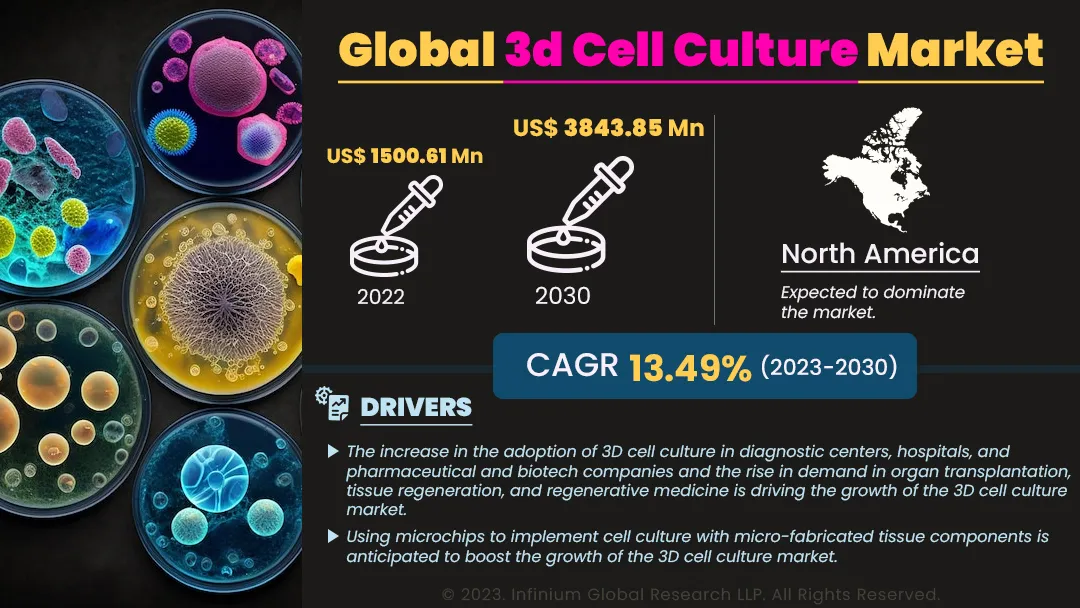3D Cell Culture Market (Product Type - Scaffold-based 3D Cell Culture, Scaffold-free 3D Cell Culture, Microfluidics-based 3D Cell Culture, Magnetic Levitation, and 3D Bio Printing; Application - Drug Discovery, Toxicology, Cancer, Stem Cell Research, and Tissue Engineering and Regenerative Medicine; End User - Pharmaceutical and Biotechnology Companies, and Research Laboratories and Institutes): Global Industry Analysis, Trends, Size, Share and Forecasts to 2030
A recent report published by Infinium Global Research on 3D cell culture market provides in-depth analysis of segments and sub-segments in the global as well as regional 3D cell culture market. The study also highlights the impact of drivers, restraints, and macro indicators on the global and regional 3D cell culture market over the short term as well as long term. The report is a comprehensive presentation of trends, forecast and dollar values of global 3D cell culture market.
Market Insight:
3D cell culture refers to the cultivation of cells in three-dimensional structures that mimic the natural environment of tissues and organs more closely than traditional two-dimensional (2D) cell culture methods. In 2D culture, cells are typically grown on flat surfaces such as petri dishes or culture plates. However, this fails to replicate living tissues' complex cellular interactions and architecture. In 3D cell culture, cells are grown within three-dimensional scaffolds or matrices that provide structural support and allow cells to interact with each other and their surroundings in a more physiologically relevant manner. These scaffolds can be made from various materials such as hydrogels, biomaterials, or biodegradable polymers. They provide a framework for cells to organize and form complex structures similar to those found in organs and tissues.
The growth of the 3D cell culture market is primarily driven by there the significant increase in the adoption of 3D cell culture in various healthcare settings, including diagnostic centers, hospitals, and pharmaceutical and biotech companies. This adoption is driven by the recognition of the advantages offered by 3D cell culture over traditional 2D cell culture methods. Moreover, there is a growing demand for 3D cell culture in fields such as organ transplantation, tissue regeneration, and regenerative medicine. The ability of 3D cell culture to mimic the complex cellular microenvironment and provide more physiologically relevant results makes it a valuable tool in these areas. Researchers and clinicians are increasingly relying on 3D cell culture techniques to develop and test new therapies, understand disease mechanisms, and improve patient outcomes. Although, the lack of Infrastructure is hampering the growth of the 3D cell culture market. Nonetheless, the emergence of microfluidics-based 3D cell culture is providing several growth opportunities for the global 3D cell culture market.

North America is expected to dominate the 3D cell culture market during the projected period primarily due to the region's advanced healthcare infrastructure and developed economies, which provide a strong foundation for adopting and utilizing 3D cell culture technologies. The presence of established market players in North America also drives market growth through their expertise, research, and development activities, and strategic initiatives. These companies contribute to innovation, product development, and overall market competitiveness. Additionally, the supportive regulatory framework in North America plays a crucial role in the success of the market. Governments in the region recognize the potential benefits of 3D cell culture and have implemented regulations and policies that facilitate its development, approval, and use. This regulatory support creates a favorable environment for market growth. Moreover, the Asia Pacific region is expected to capture a significant share of the 3D cell culture market. Companies in the region attribute this to factors such as the high burden of chronic diseases, a flourishing biotechnology sector, lower operating costs, and increasing investments. The rising demand for cellular therapies, the growth of biobanks, and strong research potential also contribute to the regional market's expansion.
Report Scope of the 3D Cell Culture Market:
| Report Coverage | Details |
|---|---|
| Market Size in 2022 | USD 1500.61 Million |
| Market Size by 2030 | USD 3843.85 Million |
| Growth Rate from 2023 to 2030 | CAGR of 13.49% |
| Largest Market | North America |
| No. of Pages | 255 |
| Market Drivers |
|
| Market Segmentation | By Product Type, By Application, and By End User |
| Regional Scope | North America, Europe, Asia Pacific, and RoW |
Segment Covered
The report on global 3D cell culture market covers segments such as product type, application, and end user. On the basis of product type, the sub-markets include scaffold-based 3D cell culture, scaffold-free 3D cell culture, microfluidics-based 3D cell culture, magnetic levitation, and 3D bio printing. On the basis of application, the sub-markets include drug discovery, toxicology, cancer, stem cell research, and tissue engineering and regenerative medicine. On the basis of end user, the sub-markets include pharmaceutical and biotechnology companies, and research laboratories and institutes.
Companies Profiled:
The report provides profiles of the companies in the market such as Thermo Fisher Scientific Inc., Merck KGaA, Tecan Trading AG, REPROCELL Inc., PromoCell GmbH, CN Bio Innovations Ltd, Lena Biosciences, SYNTHECON, INCORPORATED, 3D Biotek LLC, and Emulate, Inc..
Report Highlights:
The report provides deep insights into demand forecasts, market trends, and micro and macro indicators. In addition, this report provides insights into the factors that are driving and restraining the growth in this market. Moreover, The IGR-Growth Matrix analysis given in the report brings an insight into the investment areas that existing or new market players can consider. The report provides insights into the market using analytical tools such as Porter's five forces analysis and DRO analysis of the 3D cell culture market. Moreover, the study highlights current market trends and provides forecasts from 2023-2030. We also have highlighted future trends in the market that will affect the demand during the forecast period. Moreover, the competitive analysis given in each regional market brings an insight into the market share of the leading players.
Please Choose One of them.